News
Recovering a mined patch of land to breathe free once more
View(s):By Tharushi Weerasinghe reporting from Muhamalai, Kilinochchi
In Muhamalai, once one of the world’s densest minefields, decades of clearance are allowing people, once displaced by the war, to finally come back home.

Vithoozen Antony
Last week, the HALO Trust, a key demining agency in Sri Lanka, celebrated the complete clearance of northern Muhamalai from landmines. During the war, the Forward Defence Line was a key military demarcation separating the Sri Lankan Army (SLA) positions in Jaffna from those held by the Liberation Tigers of Tamil Eelam (LTTE) in Kilinochchi. Land mines were used heavily by both sides as fighting for access along the famed A9 intensified.

Gnanamma: Displaced many times
“The farms were turned into frontlines when I was in primary school. Now I get to be part of a team returning them to the lives they belong to,” said a HALO Trust International Operations Manager, Vithoozen Antony. Like many others, his childhood was disrupted by displacement during the war. But his story is one of restoration, as he now leads teams of hundreds — many from local communities —through the painstaking task of extracting one of the world’s most deadly, and now illegal, weapons of war from soil that once fed the country with its rice and coconut.
On Tuesday, the Sunday Times travelled across the entirety of the cleared area, including safe parts of southern Muhamalai, and met with deminers and residents who are all part of a community finding meaning and survival in what many call God’s work. A church, a school, and a community centre flank the road around the control point.
With our safety ensured by Mr. Antony and a team of experienced local deminers, we began the tour at the Muhamalai Control Point — once the heart of the mine lines — where we received our security briefing. From there, we drove through stretches of palmyrah trees and thick bush, areas that, just moments earlier, had appeared completely red on a landmine map due to the high density of mines once buried there.
At the first stop, a backhoe was breaking through the bush, newly cleared land being prepared for farming by its owners. Just metres away, a former LTTE bunker, only discovered during demining, lay collecting water, holding secrets from a no man’s land. Other locations were less secret, as decaying kovils, deserted as devotees fled the violence of war, lay riddled with shrapnel holes.
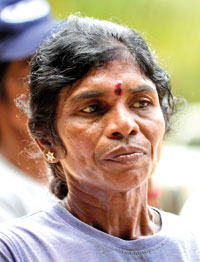
Lathaladchumi: A deminer
Demining is also underway in the Muhamalai lagoon, a challenging area due to seasonal access and complex terrain. Initially, during the dry season, teams had a four-month window to excavate and decontaminate soil before the tides rose. “Now we use an amphibious excavator which lets us go into the shallow water to do mine clearing,” Mr. Antony noted.
The task was still arduous as it required them to build a road as they went further into the shallow mined lagoon. The Sri Lankan Army had laid mines between two narrow lanes across the lagoon, which are now marked with red-dipped sticks.
Palmyrah trunks, once used to support barbed wire fences during the war, still mark former army boundaries. Clearance in the lagoon uses IED-protected machinery, but progress is slow due to the presence of active minefields on either side of the access paths, keeping the area in a red zone.
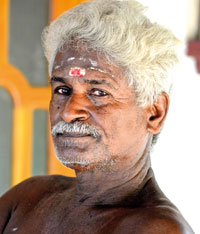
Rasadurai: Back to farming
“I joined because I wanted to clear our lands,” says Lathaladchumi, 49, who trained as a deminer with the HALO Trust in Palai and joined operations in March 2012. At the Nagercoil site, she witnessed the aftermath of mine accidents during training. Friends and family tried to dissuade her. But she stayed. “I will continue as long as the mines last,” she says. “I don’t want others to suffer like we did.”
Demining shifts run from 6 a.m. to 12 p.m. and 12 p.m. to 6 p.m. Those on the morning shift often wake up as early as 2 a.m. to manage household duties before catching a 4 a.m. shuttle to the site. They work in 40-minute intervals with 10-minute breaks, wearing heavy protective gear under the intense northern sun.
For many deminers, this work is a vital lifeline supporting their families. Most are former LTTE cadres — rehabilitated fighters — with 60% of HALO Trust staff coming from this background. Many deminers are women, as the war left numerous households headed by women who now shoulder significant responsibilities.
“This job gives my family stability, and I am trying to build a house,” says Arunthavaselvan Rasi, another deminer from Kudathanna.
Priya, 37, also echoes her thoughts, “I have three children, and this job puts me in a good position financially.” All staff have mandatory insurance under the employer’s coverage, and child care is provided in most organisations.

A deminer carries a live mine to the disposal area. Pix by Indika Handuwala
But job losses in the hundreds are inevitable as more minefields are cleared and when Sri Lanka is finally mine-free.
In preparation, Mines Advisory Group (MAG) is spearheading a programme to prepare deminers for transitions into alternative livelihoods. Officials from the National Mine Action Centre confirmed that staff have already received training in financial management, language, and performance arts, with plans to expand into IT, tailoring, welding, and public sector (peshadharma) skills in the future.
Partnerships with other ministries to provide vocational training are also underway. Every deminer can also receive a driving license as part of their progression. As Sri Lanka works toward becoming mine-free by 2028, a significant staff reduction is expected, making this upskilling crucial.
“The training and upskilling they receive, however, is resulting in very drastic visible change in them — they have an identity that is confident and independent now, especially when they have intensive first aid knowledge,” said Chief Medical Officer Dr. S. Sutharshan. He observed that equal pay and treatment, while the bare minimum, were empowering to local communities that had largely women-run households.
For residents like Rasadurai Rasendran, 64, homecoming was two decades in the making. Displaced in 2000, Mr. Rasendran returned to Indirapuram, a village in the area, in 2021 after his land was cleared. “It looked like a playground — flat and bare. My small house was gone,” he recalls. “We tried to come back before, but couldn’t until it was safe.”
Now a farmer again, Rasendran and his family of eight live in a resettled community of over 200 families, rebuilt with support from the government: shelters, toilets, water pumps, and fencing. His home sits on an acre of land with a home garden and lots of pets running around, from dogs to chickens. Municipal services, however, have been slower to catch up.
Even after years of appeals, parts of Indirapuram remain without electricity. The Sunday Times confirmed that this was an issue in one half of the village and not the other. “We have lots of dogs because snakes tend to come in the night when we keep doors open because of the heat, and the dogs alert us to them.
The Sunday Times reached out to the Governor of the Northern Province, R. Vedanayagam, who was surprised by the fact. “I will have to check with the Divisional Secretariat, but I highly doubt this is the case,” he noted.
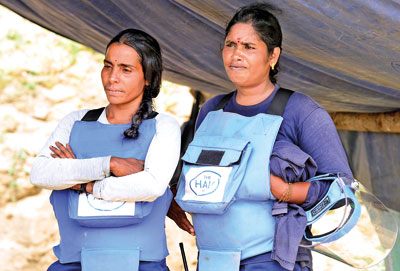
Two female deminers
The National Mine Action Centre (NMAC) oversees quality assurance and control of all mine clearance activities in Sri Lanka. NMAC officers visit demining sites every two weeks to ensure operations follow Sri Lankan and international standards, as well as each organisation’s standard operating procedures. Once a clearance team completes work in a given area, they submit a clearance map and report to NMAC. The NMAC team then verifies the location on the ground using GPS grid coordinates and bearings, before officially taking over the site.
Following verification, NMAC prepares a detailed report and produces four signed copies. These are forwarded to the Government Agent (GA) of the district, who also signs them. One copy each is retained by the Divisional Secretariat, NMAC, the implementing demining organisation, and the relevant district authority. Once this process is complete, the land is formally released.
The planning department is then informed, allowing the resettlement or cultivation to begin. Ownership records are used to determine who is entitled to return, and landowners can obtain a copy of the clearance certificate from any of the involved organisations. If needed, grid coordinates are used to guide landowners to their plots, and NMAC prepares a final report based on these confirmations.
Resettlement has been life-changing for Ganesan Ganapathy Gnanamma, 43, who has faced multiple displacements throughout her life. “I was moved to Muhamalai from Grandpass by a priest after my parents died when I was six. Then he left suddenly, and I was placed in an orphanage,” she said. At 19, while living in Madu, she sustained severe burns when an SLA bomb struck the bunker she was in. “I didn’t even have hair on my head after that — my brother had to take a loan so I could get plastic surgery,” she recalled.
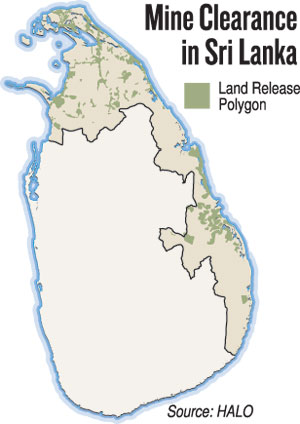
Years later, she discovered that the priest had left plots of land in Muhamalai to the children he once fostered. Today, she lives and works on that land, running several small businesses. “Even the deminers and people from the GA’s office buy my food — they love my lunudehi and Maldive fish sambal,” she said, adding that she now employs five others in a carpet stitching business.
“We used to worry that every step we took would be our last. I cannot explain the freedom I feel now — being able to walk without fear in a place I can call my own is something I’ll never take for granted.”
| Mechanical tools, physical labour dig up mines Mine clearance in Sri Lanka follows a combination of mechanical and manual methods, adapted to the terrain, type of explosive, and safety considerations. Mechanical clearance involves the use of armoured machines, especially in areas with known or suspected anti-vehicle mines. For more precise work, the manual rake method is used. This involves clearing land in small sections, typically up to a depth of 15 centimetres, following international standards, since most anti-personnel mines are designed to trigger under that level of pressure. 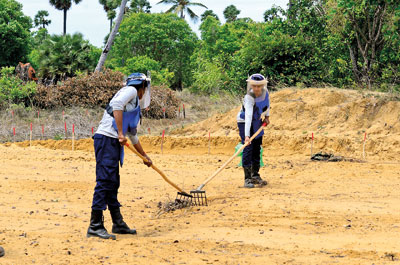 Clearing mines manually The HALO Trust and the Sri Lankan Army use a 15 cm excavation drill for this purpose. In cases where mines may be buried deeper due to soil erosion or floods, such as on slopes like Nagerkovil, mechanical methods are used to reach below 15 cm. Manual clearance also includes using metal detectors, when soil conditions and mine types allow, and raking, in areas with high metal contamination. Mines with low metal content are searched manually. Mine detection dogs are also used, though only by the army’s engineering units and the Humanitarian Demining Unit (HDU). Identifying contaminated areas starts with a survey or community liaison teams. Each demining organisation deploys teams that gather local knowledge — often from former LTTE cadres, hunters, army patrol records, and civilians who found mines while collecting firewood or farming. These sources help confirm the presence of mines, with grid lines marked using GPS. Minefields around former LTTE or army camps are common. All findings are verified with army confirmation and certified by the local Grama Niladhari, then reported to the demining operation manager. 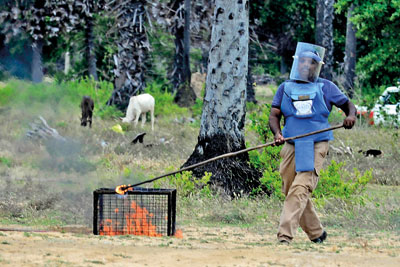 Mines are disposed of by burning Explosives are usually disposed of on the same day. Anti-personnel mines are typically burned rather than dismantled, after several accidents prompted a shift in protocol. The mines are put into a cage-like structure and doused in kerosene before being set on fire. All in the presence of an SLA officer who confirms the weapons were destroyed. Conventional weapons like mortars and grenades are blasted in controlled demolitions done only in the presence of army soldiers. The Sri Lankan Army remains the sole authority for explosives demolition, while a national technical working group oversees standards and coordination across all demining stakeholders. During our visit, the Sunday Times also observed that the bags of deminers were checked by soldiers at the end of each shift to ensure that weapons are not smuggled out.
| |
| Global, local hands remove deadly ordnanceExperts estimate that around 1.6 million landmines remain unmarked in Sri Lanka’s north and east, areas long contested by the army and the LTTE. Sixteen years after the war’s end, local deminers work painstakingly to clear land and enable displaced communities to return safely. Despite these efforts, landmines remain deadly, as tragically seen in a child’s death as recently as 2023. Although Sri Lanka signed the 1997 Ottawa Convention banning landmines in 2018 and aimed to be mine-free by 2020, the deadline has been extended to 2028. Mine clearance is coordinated by the National Mine Action Centre (NMAC), working with national and international partners including DASH, SHARP, HALO Trust, GICHD, and the Sri Lankan Army. The current National Mine Action Completion Strategy (2023–2027), developed with GICHD support, builds on past progress and aligns Sri Lanka’s commitments to international treaties and Sustainable Development Goals. Commenting on the progress up to the 2028 goal, an official from NMAC told the Sunday Times that a completion survey is currently underway, with different organisations assigned to specific regions. The HALO Trust is covering Jaffna, Kilinochchi, and parts of Mullaitivu; SHARP is working in the Pudukuduirippu Divisional Secretariat and the Thanthirimale area in Anuradhapura; MAG is responsible for areas in the Northern Province as well as Ampara, Batticaloa, Trincomalee, Polonnaruwa, Mannar, and Vavuniya; while DASH is operating in Mullaitivu’s Weli Oya, Oddusuddan, and Maritimepattu. “Each organisation will report their findings to us, and based on their data, we will be able to make a final assessment.” Land littered with mines by combatants Sri Lanka remains one of the most heavily mined countries in the world, with landmines laid extensively by both the Sri Lankan Army and the LTTE throughout the civil war. Many of the mines being tracked down today are those used by the army, as locations are easier to track based on records. The history of landmine use is separated into four phases, starting in 1987 when the Indian Peacekeeping Force arrived in Jaffna. In response, the LTTE retreated into the Mullaitivu jungles and began masking improvised mines. The first, called the “Johnny,” was a wooden-cased device powered by two AA batteries. Around 14 satellite camps formed a ring around a central jungle base, and the entire area was mined. In 1995, following the LTTE’s withdrawal from Jaffna, two large-scale mine belts were laid from Point Pedro to Chavakachcheri. The peninsula was declared a High Security Zone, covering 215 square kilometres. Around Palaly and Kankesanthurai ports, the Sri Lankan Army allowed civilian resettlement only after six months. In the early 2000s, the narrow strip at Muhamalai became one of the most mine-dense areas in the world. Although the army controlled Jaffna town, the LTTE retained surrounding areas, and during the 32-day battle for Elephant Pass, both land and sea supply routes were cut off. The LTTE established a northern defensive line to slow advancing troops. In the final phase of the war, as the LTTE withdrew through Mannar, they laid explosive-laden bunds, continuing through to Kilaly. These last-ditch defences marked the southernmost edge of their mined frontlines. The Sri Lankan Army used both anti-personnel and anti-vehicle mines, including the P4 from Pakistan and others sourced from China and the U.S. The LTTE’s mines became more sophisticated over time, evolving into Johnny 95 and Johnny 99 — pressure-activated devices with internal springs. Pendulum-based anti-tilt mines, designed to detonate on disturbance, were especially difficult to clear. Anti-vehicle mines known as “Amman,” named after an LTTE cadre, also used tilt mechanisms. Improvised explosive devices were made in individual LTTE camps using locally available materials. Due to their use in IEDs, everyday items like bicycle bolts and batteries were banned in some areas. Mine clearance teams today rely on armoured machinery tailored to the type of explosive. Larger anti-vehicle mines are removed with rakes and excavators, while smaller devices require sifters and hand tools. Strict safety measures, including protective body gear and enforced distance protocols, are followed to prevent injuries from secondary fragmentation.
|
The best way to say that you found the home of your dreams is by finding it on Hitad.lk. We have listings for apartments for sale or rent in Sri Lanka, no matter what locale you're looking for! Whether you live in Colombo, Galle, Kandy, Matara, Jaffna and more - we've got them all!

